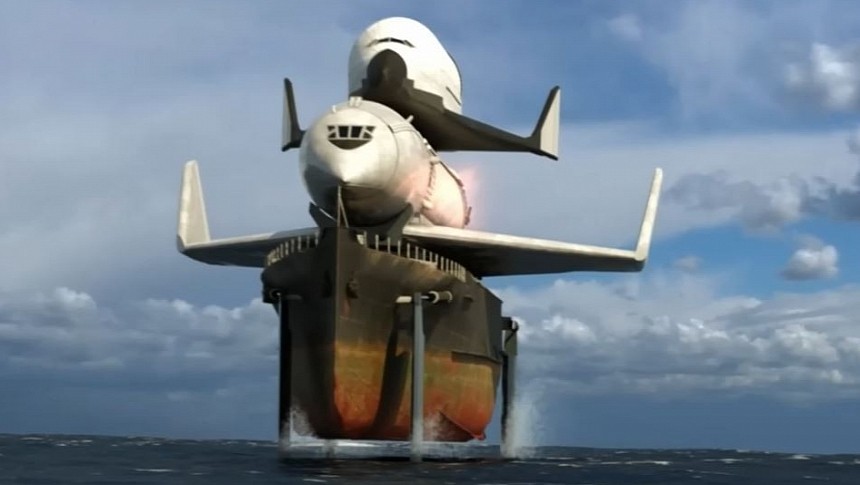A couple of years ago, we shared with you the story of the USS Plainview, a U.S. Navy hydrofoil ship that was powered by the same General Electric J79 turbojet engines you'd find in a jet fighter. If you thought this was the ultimate form of bonkers hydrofoil designs, well, you'd only be half right. While the mighty Plainview at least made it off the drawing board, the Soviet Union had plans in the works for something even more insane. That's right. Back in 1974, the Communists had a plan for a Space Shuttle competitor launched from a hydrofoil.
Dubbed the Alexeyev Sukhoi Albatros, if the American Space Shuttle was bonkers, the Albatros turned the lunacy up to 11. Designed by the combined team of the Alekseyev OKB-21 design bureau and one of the longest-serving Soviet aerospace contractors at Sukhoi, the Albatross consisted of a triple-stage-to-orbit system. The first stage was little more than a traditional sea vessel powered in the water by a typical diesel-powered propeller. When floating out on the Caspian Sea or Lake Baikal, the Albatross's two upper stages, loaded with liquid hydrogen fuel and liquid oxidizer, sat in the wait, ready to fire its engines when given the signal to launch.
When the signal was given, like the USS Plainview, the Albatross's hydrofoil first stage will deploy its water skis from the side of the hull, lifting the ship a few feet off the water. Once the second stage's engines fire, the whole ship begins its perilous acceleration up to 180 kph, or 111 mph, where the second and third stages detach from the hydrofoil first stage, sending it like a passenger airliner down a tarmac runway up towards the heavens. In total, the hydrofoil would spend roughly 110 seconds rocketing across the water.
Only when the second and third stages had pierced through the dense lower atmosphere at the ragged edge of space did the two stages separate, sending the Soviet shuttle's third stage on a trajectory to reach low-Earth orbit upon activating its main engines. Like a SpaceX Falcon 9 with wings, the second-stage rocket plane/booster vehicle was engineered to glide back to Earth after deploying the third-stage shuttle to space before touching down on a runway local to whichever body of water the craft was launched from.
In practice, such an needlessly complex Rube Goldberg machine probably would have made the American Space Shuttle look like a Toyota Camry by comparison. That said, we're so happy that our favorite YouTube 3D animator, Hazegrayart, helped show us what the wild spacecraft would have looked like had the Kremlin been daft enough to give it a try. Check out the amazing video down below and show them some much-deserved support.
When the signal was given, like the USS Plainview, the Albatross's hydrofoil first stage will deploy its water skis from the side of the hull, lifting the ship a few feet off the water. Once the second stage's engines fire, the whole ship begins its perilous acceleration up to 180 kph, or 111 mph, where the second and third stages detach from the hydrofoil first stage, sending it like a passenger airliner down a tarmac runway up towards the heavens. In total, the hydrofoil would spend roughly 110 seconds rocketing across the water.
Only when the second and third stages had pierced through the dense lower atmosphere at the ragged edge of space did the two stages separate, sending the Soviet shuttle's third stage on a trajectory to reach low-Earth orbit upon activating its main engines. Like a SpaceX Falcon 9 with wings, the second-stage rocket plane/booster vehicle was engineered to glide back to Earth after deploying the third-stage shuttle to space before touching down on a runway local to whichever body of water the craft was launched from.
In practice, such an needlessly complex Rube Goldberg machine probably would have made the American Space Shuttle look like a Toyota Camry by comparison. That said, we're so happy that our favorite YouTube 3D animator, Hazegrayart, helped show us what the wild spacecraft would have looked like had the Kremlin been daft enough to give it a try. Check out the amazing video down below and show them some much-deserved support.











